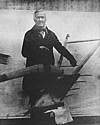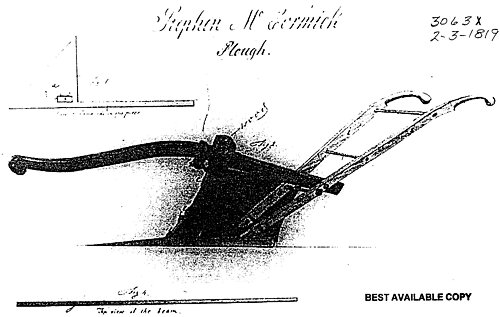 (source)
(source)
|
Stephen McCormick
(26 Aug 1784 - 28 Aug 1875)
American inventor and manufacturer who invented and manufactured a practical cast iron plow with detachable components. His was an early use of standardization of replaceable parts which led to the development of improved manufacturing processes.
|
X3063

To all whom it may concern:
Be it known that I, Stephen McCormick, of Fauquier County, Virginia, have invented an Improvement in Plows, of which the following is a specification.
This plow has a plate of wrought-iron added to a bar, which forms the landside, point, and share. There is a mortise-hole through the share, near the bar, to receive the sheath and brace.
The mold-board is made of cast-iron, and is so constructed as to fit on the share end. It has a perpendicular landside of ten inches or less, (agreeable to the size of the plow,) which has a shoulder that butts against the sheath. The front part of the mold-board has a gradual rise to the highest part of the lower edge of the mold-board, and has a circular shape, which forms a gradual rise to a right angle to the landside. The upper edge widens gradually until it hangs over the heel or bottom part six or eight inches. The mold-board is confined to the sheath by two rivets and by two to the stilt. The share is confined to the mold-board by a brace passing in front of the sheath through the wood or by this side of an iron beam which is fastened by a screw; also, a screw passing through near the edge of the mold board and share. The bead is confined by a screw to the stilt.
The beam is made of iron; is about six feet long, with a considerable curve, two inches and a half wide, and one and an eighth thick, which is large enough for three horses. The front end has holes to admit an open ring or clevis; also, a hole through the other end, where it comes into the stilt, which is confined by a rivet-pin. This beam is let into the top of the sheath, which is made of wood, and is confined by a cap of the iron. The beam has a band of iron about five inches in front of the sheath, which is large enough on the under edge of the beam to admit a hook of one end of a brace which passes through the sheath and stilt near the heel of the plow, which is fastened by a screw. The stilts are made of wood, about five and a half feet long.
Benjn. Fenwick.
- 26 Aug - short biography, births, deaths and events on date of McCormick's birth.
- Stephen McCormick - Biography
- Stephen McCormick, U.S. Patent X4325 (28 Jan 1826) - the second patent on his plow.
- Stephen McCormick, U.S. Patent 501 (1 Dec 1837) - the third patent on his plow.




